How to Back Up
Driving in reverse, or "backing up," is one of the more complex driving skills to master. Unlike forward motion, where you have a clear view of what's in front of you, driving in reverse requires you to turn around to see what's behind you. New and seasoned drivers alike must stay alert and cautious when backing up.
How to Back Up in a Straight Line
Most of your backing up will likely be in a straight line. You must be 100% sure there is nothing behind you before you begin to back up. Check all three of your mirrors, then turn your head 180 degrees to look behind you. Check to the sides of your vehicle just in case anyone is walking toward you. Look closer to the ground for small children or animals, especially in residential areas.
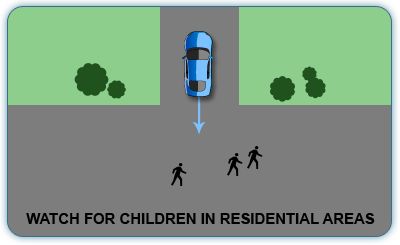 Backing Up
Backing Up
If you see a pedestrian approaching, try to make eye contact with them. If they stop and wave you forward, it's likely safe to back up, but don't take this as an invitation to stop paying attention to your surroundings. Otherwise, wait until the roadway is clear before reversing.
When your path is clear, put your foot on the brake pedal. Place your left hand at the top of your steering wheel, as pictured below. Driving in reverse is the only time you'll use one-hand steering like this.
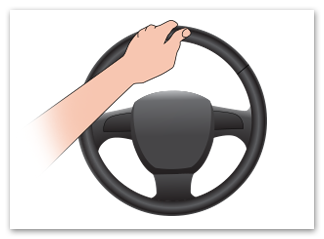 Position your left hand at the top of the steering wheel.
Position your left hand at the top of the steering wheel.
Next, put your vehicle in "Reverse," keeping your foot on the brake. Turn your body around in your seat so that you're looking out the back window, over your right shoulder. When your path of travel is clear, slowly reduce pressure off the brake pedal. Most of the time, you won't need to use the gas pedal while backing up. Keep your foot over the brake as you begin to reverse. This is called "Covering the Brake," and helps make sure that you don't accelerate too quickly, and that you can stop quickly if needed.
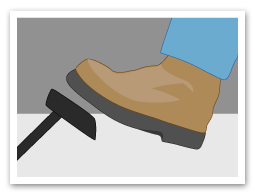 Covering the Brake
Covering the Brake
As you release pressure from the brake, your vehicle will begin backing up. Back up slowly, and keep an eye out for pedestrians and other vehicles. Once you're finished reversing, turn back around in your seat and put your foot back on the brake pedal. Shift to drive, check to make sure the path in front of you and to your sides is clear, and you're ready to go!
How to Turn While Backing Up
Sometimes you'll need to turn as you reverse, such as when you're backing into a perpendicular parking space. It’s safer to drive out of a perpendicular space than it is to back out, so consider backing into the parking space when you can. It also gives you a better view when leaving the space and lets you avoid backing out into traffic.
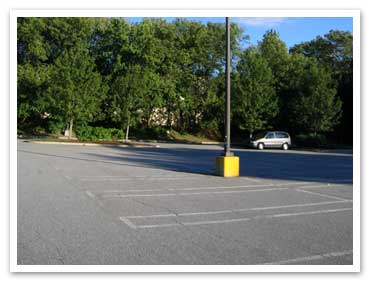 Perpendicular Parking Spaces
Perpendicular Parking Spaces
Here are some steps to follow when backing into a perpendicular parking spot:
- Signal to the right.
- Slow down and approach the space from about 3 feet away.
- Stop when your body appears to be aligned in the center of the parking space.
- Signal to the left and check for traffic and pedestrians.
- When it's clear, drive forward slowly and turn the wheel quickly to the left and move to a 45-degree angle to the space.
- Stop, then shift to “Reverse.”
- Look over your right shoulder to check your alignment in the space.
- Move slowly and turn the wheel sharply toward the center of the space.
- Once you’re in the space, straighten your wheels and center your car in the space.
- Stop even with the curb or parking line.
Sometimes, you won't be able to back into a perpendicular parking space, so you'll have to back out of it. That's okay, as long as you're being cautious. Here are the steps to follow:
- Check for other vehicles and pedestrians. To do this, check all of your mirrors and turn behind you and look over your right shoulder.
- Use your turn signal to let those around you know which way you're going to be moving.
- Put your foot on the brake and shift to "Reverse."
- While still looking behind you, lift your foot off the brake and slowly drift backward.
- Begin turning when your front bumper is level with the rear bumper of the car beside you.
- When you are clear of the space, check for pedestrians and other vehicles again.
- Straighten your wheels and stop.
- Shift your car into “Drive” and accelerate slowly.
Other times, you'll need to back out at an angle. Take a look at the illustration below.
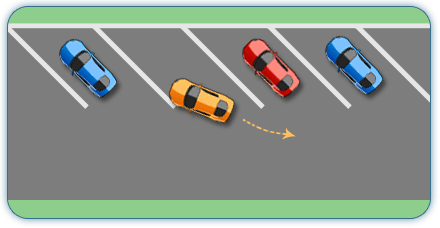 Angled Parking Spaces
Angled Parking Spaces
When backing out of an angled parking space, do the following:
- Check behind your vehicle before entering. Look for items such as carts and debris.
- When you’re in your vehicle, check your left and right-side mirrors as well as your blind spots. Continue looking behind you as you reverse. If a large vehicle is parked behind you, be cautious and back out slowly, because it may block your view.
- Move out slowly, and make sure traffic is clear in the lane you are entering.
- When you can see past the tops of the cars parked next to you, stop and look again. Look back and to each side for pedestrians and other drivers.
- Back out straight, slowly, until your front bumper is level with the rear bumper of the car next to you. Then, turn sharply in the direction you wish to back your car.
- Straighten the wheels as your car enters the lane of traffic. Stop, shift gears and accelerate slowly.
A Back-Up Camera Can't Replace Your Eyes
Your back-up camera, if your vehicle has one, should be used in conjunction with the steps outlined above. Think of it as an extra set of eyes. It's not a replacement for your eyes.
If your vehicle is equipped with a back-up camera, it will usually turn on when you put your vehicle in "Reverse." Most steps of the process will remain the same when using a backup camera; you must still check behind you by looking over your shoulders and checking your mirrors.
When your surroundings are clear, you can back up as you normally would, checking the monitor in addition to checking over your shoulders and your mirrors. There's always a chance that the back-up camera doesn't detect an object that could be a hazard.
Take an Online Course to Learn More
We offer courses in a variety of topics including Defensive Driving and Driver Education. In addition to teaching you how to be a safe driver, our courses can help you dismiss a ticket, get your driver license, or even get an insurance discount. We also have courses specifically tailored to mature drivers (i.e., drivers age 55 and older) for insurance discounts.